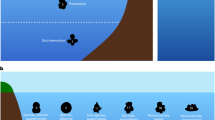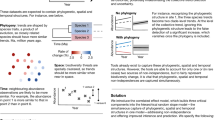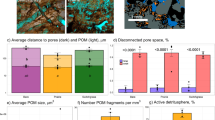Abstract
Excessive nutrient loading of water bodies is a leading cause of water pollution worldwide1,2, and controlling nutrient levels in watersheds is a primary objective of most environmental policy3. Over the past two decades, much research has shown that ecosystems with more species are more efficient at removing nutrients from soil and water than are ecosystems with fewer species4,5,6,7. This has led some to suggest that conservation of biodiversity might be a useful tool for managing nutrient uptake and storage7,8,9,10, but this suggestion has been controversial, in part because the specific biological mechanisms by which species diversity influences nutrient uptake have not been identified10,11,12. Here I use a model system of stream biofilms to show that niche partitioning among species of algae can increase the uptake and storage of nitrate, a nutrient pollutant of global concern. I manipulated the number of species of algae growing in the biofilms of 150 stream mesocosms that had been set up to mimic the variety of flow habitats and disturbance regimes that are typical of natural streams. Nitrogen uptake rates, as measured by using 15N-labelled nitrate, increased linearly with species richness and were driven by niche differences among species. As different forms of algae came to dominate each unique habitat in a stream, the more diverse communities achieved a higher biomass and greater 15N uptake. When these niche opportunities were experimentally removed by making all of the habitats in a stream uniform, diversity did not influence nitrogen uptake, and biofilms collapsed to a single dominant species. These results provide direct evidence that communities with more species take greater advantage of the niche opportunities in an environment, and this allows diverse systems to capture a greater proportion of biologically available resources such as nitrogen. One implication is that biodiversity may help to buffer natural ecosystems against the ecological impacts of nutrient pollution.
This is a preview of subscription content, access via your institution
Access options
Subscribe to this journal
Receive 51 print issues and online access
$199.00 per year
only $3.90 per issue
Buy this article
- Purchase on Springer Link
- Instant access to full article PDF
Prices may be subject to local taxes which are calculated during checkout


Similar content being viewed by others
References
Vitousek, P. M. et al. Human alteration of the global nitrogen cycle: sources and consequences. Ecol. Appl. 7, 737–750 (1997)
Canfield, D. E., Glazer, A. N. & Falkowski, P. G. The evolution and future of Earth’s nitrogen cycle. Science 330, 192–196 (2010)
Smith, V. H. & Schindler, D. W. Eutrophication science: where do we go from here? Trends Ecol. Evol. 24, 201–207 (2009)
Spehn, E. M. et al. Ecosystem effects of biodiversity manipulations in European grasslands. Ecol. Monogr. 75, 37–63 (2005)
Cardinale, B. J. et al. Effects of biodiversity on the functioning of trophic groups and ecosystems. Nature 443, 989–992 (2006)
Bracken, M. E. S. & Stachowicz, J. J. Seaweed diversity enhances nitrogen uptake via complementary use of nitrate and ammonium. Ecology 87, 2397–2403 (2006)
Tilman, D., Wedin, D. & Knops, J. Productivity and sustainability influenced by biodiversity in grassland ecosystems. Nature 379, 718–720 (1996)
Scherer-Lorenzen, M., Palmborg, C., Prinz, A. & Schulze, E. D. The role of plant diversity and composition for nitrate leaching in grasslands. Ecology 84, 1539–1552 (2003)
Reich, P. B. et al. Plant diversity enhances ecosystem responses to elevated CO2 and nitrogen deposition. Nature 410, 809–812 (2001)
Hooper, D. U. et al. Effects of biodiversity on ecosystem functioning: a consensus of current knowledge. Ecol. Monogr. 75, 3–35 (2005)
Huston, M. A. Hidden treatments in ecological experiments: re-evaluating the ecosystem function of biodiversity. Oecologia 110, 449–460 (1997)
Loreau, M. et al. Biodiversity and ecosystem functioning: current knowledge and future challenges. Science 294, 804–808 (2001)
Carpenter, S. R. et al. Nonpoint pollution of surface waters with phosphorus and nitrogen. Ecol. Appl. 8, 559–568 (1998)
Dodds, W. K. Eutrophication and trophic state in rivers and streams. Limnol. Oceanogr. 51, 671–680 (2006)
Mulholland, P. J. et al. Stream denitrification across biomes and its response to anthropogenic nitrate loading. Nature 452, 202–205 (2008)
Alexander, R. B., Smith, R. A. & Schwarz, G. E. Effect of stream channel size on the delivery of nitrogen to the Gulf of Mexico. Nature 403, 758–761 (2000)
Anderson, D. M., Glibert, P. M. & Burkholder, J. M. Harmful algal blooms and eutrophication: nutrient sources, composition, and consequences. Estuaries 25, 704–726 (2002)
Diaz, R. J. & Rosenberg, R. Spreading dead zones and consequences for marine ecosystems. Science 321, 926–929 (2008)
Dodds, W. K. et al. Eutrophication of US freshwaters: analysis of potential economic damages. Environ. Sci. Technol. 43, 12–19 (2009)
Tilman, D., Lehman, D. & Thompson, K. Plant diversity and ecosystem productivity: theoretical considerations. Proc. Natl Acad. Sci. USA 94, 1857–1861 (1997)
Chapin, F. S. et al. Biotic control over the functioning of ecosystems. Science 277, 500–504 (1997)
Cardinale, B. J. et al. The functional role of producer diversity in ecosystems. Am. J. Bot. 98, 572–592 (2011)
Chesson, P. Mechanisms of maintenance of species diversity. Annu. Rev. Ecol. Syst. 31, 343–366 (2000)
Loreau, M. & Hector, A. Partitioning selection and complementarity in biodiversity experiments. Nature 412, 72–76 (2001)
Peterson, C. G. & Stevenson, R. J. Resistance and resilience of lotic algal communities: importance of disturbance timing and current. Ecology 73, 1445–1461 (1992)
Biggs, B. J. F. & Thomsen, H. A. Disturbance of stream periphyton by perturbations in shear stress: time to structural failure and differences in community resistance. J. Phycol. 31, 233–241 (1995)
Steinman, A. D. & McIntire, C. D. Effects of current velocity and light energy on the structure of periphyton assemblages in laboratory streams. J. Phycol. 22, 352–361 (1986)
Pringle, C. M. Patch dynamics in lotic systems: the stream as a mosaic. J. N. Am. Benthol. Soc. 7, 503–524 (1988)
Poff, N. L., Olden, J. D., Merritt, D. M. & Pepin, D. M. Homogenization of regional river dynamics by dams and global biodiversity implications. Proc. Natl Acad. Sci. USA 104, 5732–5737 (2007)
Cardinale, B. J., Bennett, D. M., Nelson, C. E. & Gross, K. Does productivity drive diversity or vice versa? A test of the multivariate productivity–diversity hypothesis in streams. Ecology 90, 1227–1241 (2009)
Biggs, B. J. F., Goring, D. G. & Nikora, V. I. Subsidy and stress responses of stream periphyton to gradients in water velocity as a function of community growth form. J. Phycol. 34, 598–607 (1998)
Passy, S. I. Spatial paradigms of lotic diatom distribution: a landscape ecology perspective. J. Phycol. 37, 370–378 (2001)
Biggs, B. J. F., Stevenson, R. J. & Lowe, R. L. A habitat matrix conceptual model for stream periphyton. Arch. Hydrobiol. 143, 21–56 (1998)
Stevenson, R. J. Effects of current and conditions simulating autogenically changing microhabitats on benthic diatom immigration. Ecology 64, 1514–1524 (1983)
Andersen, R. A. Algal Culturing Techniques (Elsevier/Academic, 2005)
Vogel, S. & LaBarbera, M. Simple flow tanks for research and teaching. Bioscience 28, 638–645 (1978)
Hubbell, S. P. et al. How many tree species are there in the Amazon and how many of them will go extinct? Proc. Natl Acad. Sci. USA 105, 11498–11504 (2008)
Stevenson, R. J. in Algal Ecology: Freshwater Benthic Ecosystems (eds Stevenson, R. J., Bothwell, M. L. & Lowe, R. L. ) 321–336 (Academic, 1996)
Poff, N. L. et al. The natural flow regime. Bioscience 47, 769–784 (1997)
Townsend, C. R. et al. Disturbance, resource supply, and food-web architecture in streams. Ecol. Lett. 1, 200–209 (1998)
Cooper, S., Barmuta, L., Sarnelle, O., Kratz, K. & Diehl, S. Quantifying spatial heterogeneity in streams. J. N. Am. Benthol. Soc. 16, 174–188 (1997)
Townsend, C. R. The patch dynamics concept of stream community ecology. J. N. Am. Benthol. Soc. 8, 36–50 (1989)
Steinman, A. D. & Lamberti, G. A. in Methods in Stream Ecology (eds Hauer, F. R. & Lamberti, G. A. ) 295–311 (Academic, 1996)
Nusch, E. A. Comparison of different methods for chlorophyll and phaeopigment determination. Arch. Hydrobiol. Beih. Ergebn. Limnol. 14, 14–36 (1980)
Fry, B. Stable Isotope Ecology (Springer, 2006)
Legendre, L. & Gosselin, M. Estimation of N or C uptake rates by phytoplankton using N-15 or C-13: revisiting the usual computation formulae. J. Plankton Res. 19, 263–271 (1997)
Johnson, J. B. & Omland, K. S. Model selection in ecology and evolution. Trends Ecol. Evol. 19, 101–108 (2004)
Carroll, I. T., Cardinale, B. J. & Nisbet, R. M. Niche and fitness differences relate the maintenance of diversity to ecosystem function. Ecology (in the press)
Loreau, M. Does functional redundancy exist? Oikos 104, 606–611 (2004)
Acknowledgements
We thank J. Byrnes, W. Dodds, J. Levine and A. Steinman for comments that improved the manuscript. D. Bennett, K. Matulich, L. Power and J. Weis helped to set up and run the experiment. M. Potapova provided images of the algae in Fig. 2. This work was funded by grants from the US National Science Foundation (DEB 0614428 and DEB 1046121).
Author information
Authors and Affiliations
Contributions
B.J.C. designed the study, collected data with the assistance of those mentioned in the Acknowledgements, analysed the data and wrote the paper.
Corresponding author
Ethics declarations
Competing interests
The author declares no competing financial interests.
Supplementary information
Supplementary Information
This file contains Supplementary Tables 1-2 and Supplementary Figure 1 with a legend. (PDF 227 kb)
PowerPoint slides
Rights and permissions
About this article
Cite this article
Cardinale, B. Biodiversity improves water quality through niche partitioning. Nature 472, 86–89 (2011). https://doi.org/10.1038/nature09904
Received:
Accepted:
Published:
Issue Date:
DOI: https://doi.org/10.1038/nature09904
This article is cited by
-
Modeling of water scarcity for spatial analysis using Water Poverty Index and fuzzy-MCDM technique
Modeling Earth Systems and Environment (2024)
-
Stochastic community assembly of abundant taxa maintains the relationship of soil biodiversity-multifunctionality under mercury stress
Soil Ecology Letters (2024)
-
Proper C/N ratio enhances the effect of plant diversity on nitrogen removal and greenhouse effect mitigation in floating constructed wetlands
Environmental Science and Pollution Research (2024)
-
Common soil history is more important than plant history for arbuscular mycorrhizal community assembly in an experimental grassland diversity gradient
Biology and Fertility of Soils (2024)
-
Diagnosing destabilization risk in global land carbon sinks
Nature (2023)
Comments
By submitting a comment you agree to abide by our Terms and Community Guidelines. If you find something abusive or that does not comply with our terms or guidelines please flag it as inappropriate.



